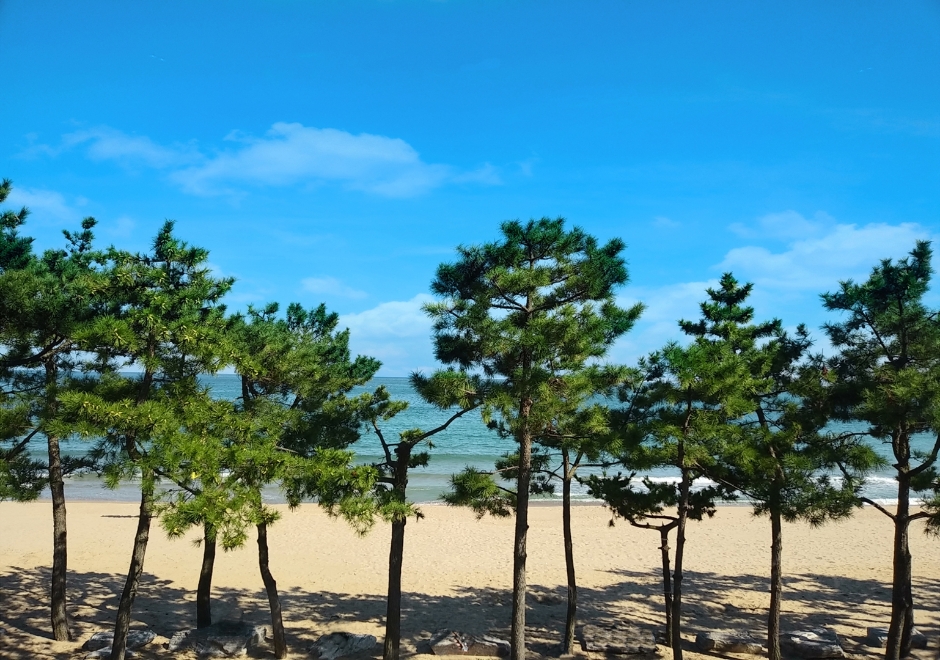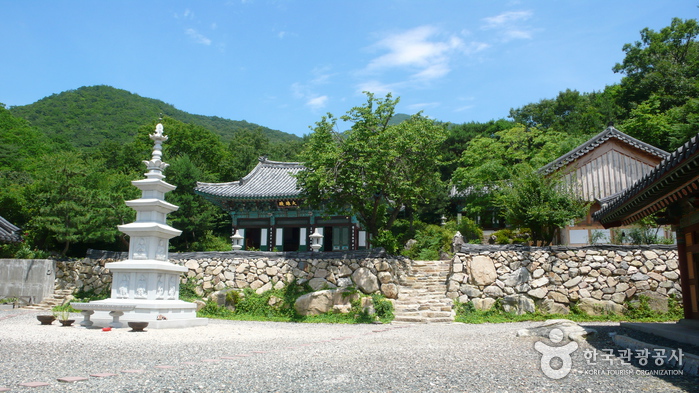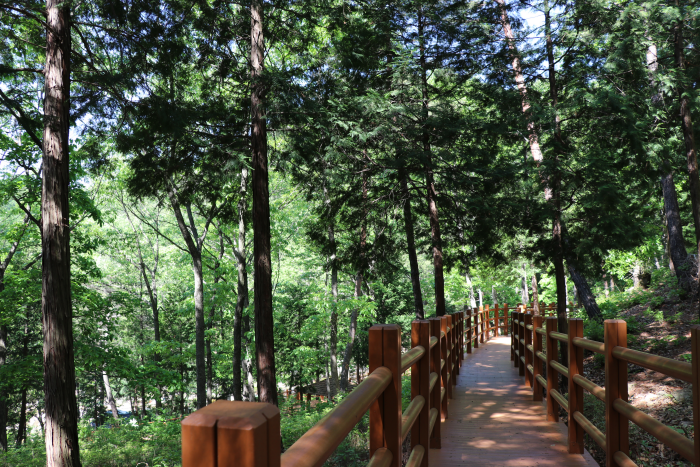Jinha Beach (진하 해수욕장)
17.4Km 2025-10-23
Jinhari, Seosaeng-myeon, Ulju-gun, Ulsan
+82-52-204-0351~4
◎ Travel information to meet Hallyu’s charm - TV series"See You in My 19th Life"
This is the beach that Seo-ha and Do-yoon, Ji-eum and Cho-won walked side-by-side. Jinha Beach is one of the most popular summer getaways in Ulsan when the blue sea, evergreen pine trees, and the Myeongseondo Island to the distance create together a breathtaking view. It is also a popular destination at night because Myeongseondo Island is illuminated with lights and media art pieces like tigers and waterfalls.
Supaeseo (숲애서)
17.9Km 2025-10-23
Anti-aging and Healing Service Experience Center, 248 Tapgol-gil, Yangsan-si, Gyeongsangnam-do
Supaeseo, which opened in July 2021, is the first publicly operated healing experience center. The center helps visitors enjoy a slow and healthy life filled with love, while being surrounded by the clean forests of Daeunsan Mountain, Yangsan. Visitors can experience therapy programs, therapy meals, and recreational accommodations all in one place. The center is dedicated to improving visitors' quality of life through rest, forest therapy, and health therapy programs in the clean nature of Daeunsan Mountain.
Naewonam Hermitage (Ulsan) (내원암 (울산))
18.2Km 2025-03-28
382, Daeunsangdae-gil, Onyang-eup, Ulju-gun, Ulsan
+82-52-238-5088
* Please be advised that this is located in one of the areas affected by the recent wildfire (as of March 27, 2025).
** For real-time wildfire information and emergency upates, visit the Korea Forestfire Information website and the National Disaster and Safety Portal.
Naewonam Hermitage is located on Daeunsan Mountain in Ulsan. Daewonsa, the once head temple of this hermitage, was located at the entrance to the complex, but only the remains exist today. The valley around the hermitage is famous for its clean and clear waters. The 500-year-old nettle tree within the hermitage grounds catches the eye for resembling an elephant. An annual music concert performed by Buddhist monks from Ulsan City takes place at Naewonam Hermitage.
National Center for Forest Therapy, Daeunsan (국립대운산치유의숲)
18.9Km 2025-10-23
225-92 Daeunsangdae-gil, Onyang-eup, Ulju-gun, Ulsan
052-237-8600
* Please be advised that this is located in one of the areas affected by the recent wildfire (as of March 27, 2025).
** For real-time wildfire information and emergency upates, visit the Korea Forestfire Information website and the National Disaster and Safety Portal.
The National Center for Forest Therapy, Daeunsan is a forest-themed well-being facility designed to boost one's immunity and promote health by leveraging various elements of the forest, including landscapes and scents. Created in the beautiful Daeunsan Forest Valley, this forest therapy center features the Grass Scent Trail, Wind Therapy Trail, and Premium Forest Trail, where various forest therapy activities are offered.
Eonyang Giwajip Bulgogi (언양기와집불고기)
19.3Km 2025-03-28
86 Heonnyang-gil, Eonyang-eup, Ulju-gun, Ulsan
* Please be advised that this is located in one of the areas affected by the recent wildfire (as of March 27, 2025).
** For real-time wildfire information and emergency upates, visit the Korea Forestfire Information website and the National Disaster and Safety Portal.
Eonyang Giwajip Bulgogi is a more than 40-year-old establishment housed in a renovated hanok with a history exceeding 100 years. Eonyang bulgogi is crafted by finely mincing beef, seasoning it with various spices, and grilling it on charcoal until it becomes wide and flat. The use of a gridiron for grilling imparts a distinct smoky flavor, and the mild seasoning contributes to a pleasant texture. When wrapped in fresh vegetables alongside pajeori (green onions), the combination produces an outstanding taste. The doenjang jjigae (soybean paste jjigae) and side dishes, known for their subtle seasoning, offer a clean and refreshing taste.
Eonyang Jinmi Bulgogi (언양진미불고기)
19.4Km 2024-02-20
33 Jungpyeong-ro, Samnam-eup, Ulju-gun, Ulsan
Eonyang Jinmi Bulgogi specializes in using Korean beef to create tender and flavorful Jinmi Bulgogi, where the natural taste of the ingredients is preserved. The signature dish features fresh beef topped with plenty of minced garlic, grilled to perfection over charcoal. The rich and well-presented side dishes, including yukhoe (beef tartare), complement the main dish and enhance the overall dining experience. The unique aspect of Eonyang Jinmi Bulgogi is the enjoyment of the dish without broth, grilling the meat on the grid and savoring it with green onion threads.
Galbi Gurakbu (갈비구락부)
19.6Km 2024-02-20
34-12 Namsangpyeong 2-gil, Samnam-eup, Ulju-gun, Ulsan
Galbi Gurakbu specializes in Eonyang bulgogi (Eonyang-style bulgogi), exclusively using the highest-grade female Korean beef. Eonyang bulgogi involves finely minced beef, generously seasoned, and grilled wide and flat on a gridiron. The mild seasoning ensures a pleasant texture without being overly stimulating. The restaurant boasts other excellent dishes, including siraegi doenjang jjigae (dried radish leaf soybean paste jjigae), so deungsim gui (grilled beef sirloin), yukhoe (beef tartare), and sogalbisal (grilled boneless galbi). Conveniently located, just a 5-minute taxi ride from KTX Ulsan Station.
Jogeummaru (조금마루)
19.9Km 2024-02-20
9 Seosangpyeonggangbyeon-gil, Samnam-eup, Ulju-gun, Ulsan
Jogeummaru is a duck specialty restaurant that exclusively utilizes domestically-raised ducks in its culinary creations. The ducks are raised with sulfur, contributing to a clean and rich flavor profile, free from undesirable odors. The signature menu features ori yangnyeom bulgogi (duck bulgogi), ori tang (duck soup), and ori sutbul gui (charcoal-grilled duck). Ori yangnyeom bulgogi entails duck marinated in a spicy seasoning, grilled on a pan with added chives. Ori tang is a meticulously prepared broth cooked for 12 hours, incorporating various vegetables. Additionally, eomnamu ori baeksuk (whole duck soup with castor aralia) offers a unique dish where duck is boiled with medicinal herbs.
Ganjeolgot Sunrise Festival (울산 간절곶 해맞이)
19.9Km 2024-11-20
189 Ganjeolgothaean-gil, Seosaeng-myeon, Ulju-gun, Ulsan
+82-52-980-2232
Ganjeolgot Cape in Ulsan is the first place in Korea to see the the sunrise each day, with its end point sticking out into the ocean. The cape is the site of the annual New Year’s Sunrise Festival. The festival starts at sunset on December 31 and is filled with a wide range of performances that last throughout the night. At first light, people can be seen quietly standing with their hands clasped together, making a wish on the newly born year as they watch the sun rise over the ocean.




 English
English
 한국어
한국어 日本語
日本語 中文(简体)
中文(简体) Deutsch
Deutsch Français
Français Español
Español Русский
Русский